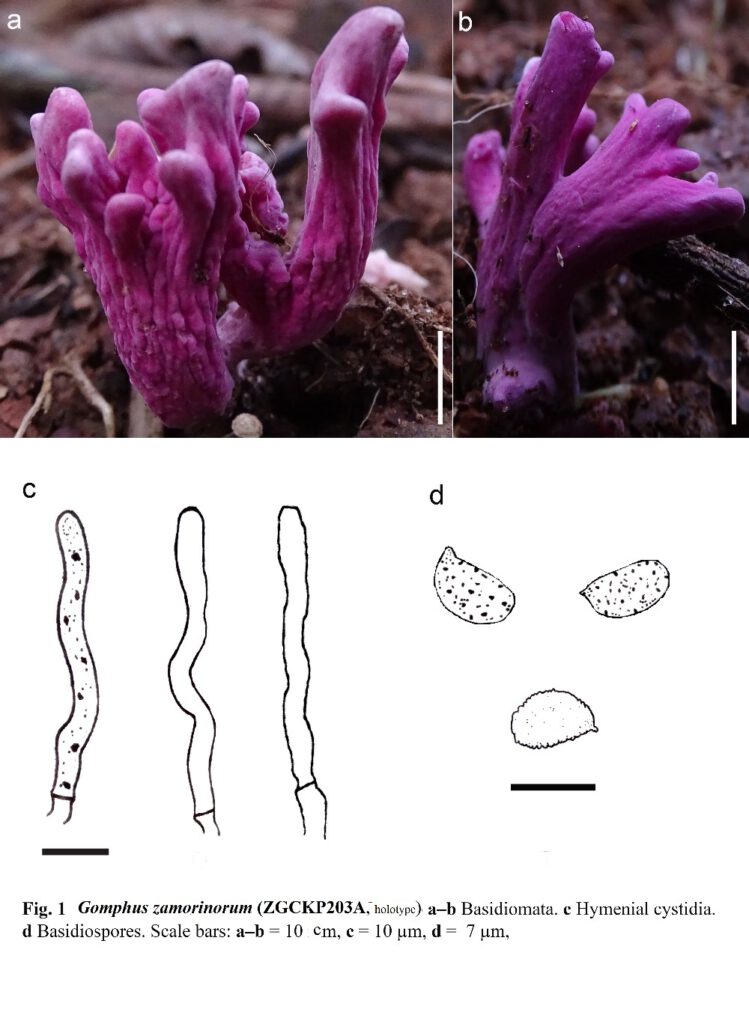Gomphus zamorinorum Krishnapriya K., T.K.A.Kumar.
MycoBank number: MB; Index Fungorum number: IF; Facesoffungi number: FoF 11792;
Description:
Basidiomata gregarious, growing as a cluster, two to three fruit bodies in a cluster, 30 to 40 mm long , 6 to 10 mm wide at the apex, not differentiated into stipe and pileus, young cylindrical fruit bodies arising from a thick rhizomorph like structure, branched (2–3) towards the apex, branches 5 to 6 mm thick, branching irregular, apex pyxidate, round or obtuse, not acute, glabrous to fibrillose young fruit bodies, mature fruitbodies becomes partially lobed downwards, branched upwards, round, with broad hymenial folds or wrinkles, ellipsoid in cross section, solid, fleshy, fragile, bright violet fruitbody, with a purplish tinch towards the apex, no color change on drying, odour pleasant. Positive reaction in Fe3Cl.
Basidiospores 6–7 × 4–5 µm (Q = 1.2–1.7 µm; Qm = 1.4 µm), phaseoliform in side view, oblong in front view, with guttulate contents (uniguttulate), verrucose, thin to thick-walled, hyaline, apiculus prominent (up to 1 µm long), in some hilar appandage is protruded up to 6–7 µm long, inamyloid, cyanophilic in cotton blue. Basidia 25–50 × 4–7 µm, uniguttulate to agguttulate, cylindrical to clavate, not smooth, incrustations present on the basidia, sterigmata 2–4 (up to 4–7 µm long), cyanophilic. Hymenial Cystidia 21–60 × 5–6 µm, cylindrical to flexuose, projecting from the hymenium, thin-walled, inamyloid, pileocystidia absent. Hymenium 80–110 µm wide. Subhymenium not distinguishable. Context composed of interwoven, irregularly arranged, encrusted, and agglutinated hypahe, hyphal constrictions present, septate, 4–8 µm wide, blackish in group, gleophorous hyphae present, in some bulged at the septal portion (up to 11 µm), thin walled, cyanophilic, inamyloid. Hyphal clamp-connections absent.
Asexual state: not observed.
Material examined: INDIA, Kerala State, Wayand district, on soil, 29 Sep 2019, (11.6942° N, 75.9081° E), (KP203A, holotype).
Distribution: INDIA, Kerala State, Wayand District, Banasura sagar dam site.
Sequence data: ITS: KP11572967 (ITS1/ITS4)
Notes: G. zamorinorum is characterised by its deep violet basidiomata with wrinkled hymenophore, branched, comparatively smaller basidiospore and basidia, presence of hymenial cystidia, presence of gleophorous hypahe, generative hyphae with ampulliform swelling and absence of clamp-connections. G. zamorinorum is similar to G. clavatus macroscopically in having the wrinkled hymenophore with deep violet colour (Giachini et al. 2012). However, G. zamorinorum differs from the latter morphologically, with its branched basidiomata, smaller basidiospore and basidia, absence of pileocystidia, presence of gloeophorous hyphae and absence of clamp-connections from all parts.

